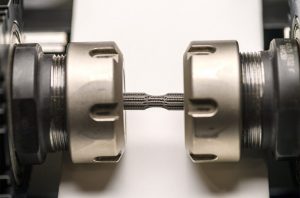[ad_1]
What biotechnological innovation should we not miss in November? A 3D laser printing at the origin of a promising new surgical material…
Replace a hip or a knee with a metal implant has become a common operation, which takes place daily all over the world. Bacterial colonization is one of the main causes of failure of such surgeries. There are many antibiotics, but their administration is not effective every time. Thus, nearly 7% of cases end with a second operation, this time extraction. First of the implant… and sometimes of the colonized limb. Researchers from Washington State University, led by Professor Amit Bandyopadhyay, wanted to bring titanium implants developed more than 50 years ago up to date. Their idea: add tantalum and copper to improve their biocompatibility and at the same time counter bacterial resistance.
Biocompatible and bacteria-resistant implants

Current implants are made of Ti6Al4V, a alliage titane-aluminium-vanadium. Amit Bandyopadhyay and his team additively manufactured their own alloy using the technique of laser powder bed fusion. This layer-by-layer process consists of fusing powder as it passes through a laser. Here, scientists mixed CpTi (more than 99% titanium) and Ti6Al4V in equivalent mass proportions to form Ti3Al2V. They then sought to evaluate the biological and mechanical properties of their new material, enriched with tantalum and copper. First, they added 3% copper (Cu) to it and put it in contact for 48 hours with bacterial lines of pyocyanin bacillus (Pseudomonas aeruginosa) and staphylococcus aureus (Staphylococcus aureus). Copper allowed a clear reduction in bacterial colonies, of 78-86% compared to CpTi. The addition of 10% tantalum (Ta) showed much better biocompatibility than Ti6Al4V, with 3.5 times greater bone formation! Finally, the complete alloy (Ti3Al2V-10Ta-3Cu) responded excellently to the various fatigue and shear resistance tests.
This work, presented on November 17, 2023 in theInternational Journal of Extreme Manufacturing, took three years to develop by researchers at Washington State University. But the end result was well worth the time spent, as this new alloy could replace old implants for orthopedic and dental surgeries in the future. The next step announced by the scientific team aims to reach the standard bacterial mortality rate, i.e. more than 99%. And this without damaging the surrounding tissues. On the Washington side, the search continues…
[ad_2]
Source link